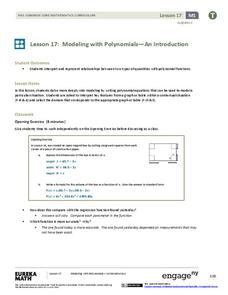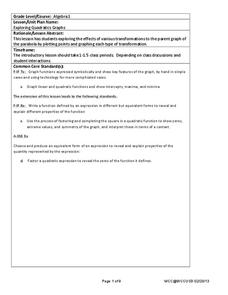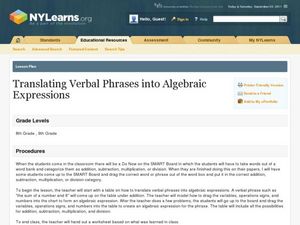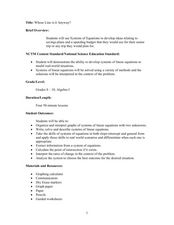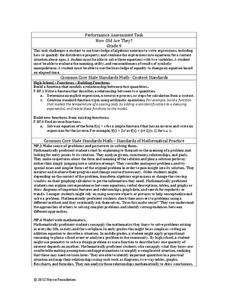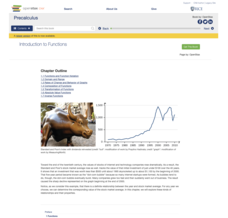EngageNY
Modeling with Polynomials—An Introduction (part 2)
Linear, quadratic, and now cubic functions can model real-life patterns. High schoolers create cubic regression equations to model different scenarios. They then use the regression equations to make predictions.
West Contra Costa Unified School District
Exploring Quadratics and Graphs
Young mathematicians first graph a series of quadratic equations, and then investigate how various parts of the equation change the graph of the function in a predictable way.
Teach Engineering
Graphing Equations on the Cartesian Plane: Slope
Slopes are not just for skiing. Instructors introduce class members to the concept of slope and teach them how to calculate the slope from a graph or from points. The lesson also includes the discussion of slopes of parallel and...
Benjamin Franklin High School
Saxon Math: Algebra 2 (Section 9)
Section 9 of the 12 linked Saxon Math sections introduces the young algebrist to graphing periodic functions, creating graphs from quadratic roots, working with inequalities, and rational equations. Common among all the lessons is the...
EngageNY
Solving Inequalities
Do properties of equations hold true for inequalities? Teach solving inequalities through the theme of properties. Your class discovers that the multiplication property of equality doesn't hold true for inequalities when multiplying by a...
Curated OER
Polynomials Functions
High schoolers factor polynomials and linear functions and apply concepts of the fundamental theorem of algebra to solve problems. They graph their solutions and analyze the graph.
Curated OER
Algebraic Relationships
Here are 17 various forms of problems that range from matching equivalent expressions to word problems. Included are problems for substutiing values into expressions and using the order of operations, simplifying algebraic expressions,...
Curated OER
Linear Systems: Applications of Eiginvalues
In this Eigenvalue and Eigenvector worksheet, students examine the applications of matrix exponentiation. This four-page worksheet provides explanations and examples, as well as three problems to complete.
Curated OER
Translating Verbal Phrases into Algebraic Expressions
Young scholars rewrite word problems using algebraic symbols. In this algebra lesson, students graph linear equations after they rewrite the equation using algebra. They relate math to the real world.
Curated OER
Linear Systems: Orthogonality of Vector Spaces of a Matrix
In this vector spaces of a matrix worksheet, students decompose any vector into two orthogonal pieces. They identify the nullspace, row space, and find a reduced echelon. This two-page worksheet contains examples and two problems.
Curated OER
Linear Systems: Nullspace Matrix and Rank
In this nullspace matrix worksheet, students observe the rank and number of independent rows and columns a matrix has. They compute the product of matrices and describe the column space of each. This two-page worksheet contains...
Curated OER
Linear Systems: Reduced Row Echelon Matrix
For this echelon matrix worksheet, students find the nullspace of matrices by finding the reduced row echelon. This two-page worksheet contains explanations, examples and six problems to complete.
Curated OER
Linear Systems: LU Decomposition
In this LU decomposition worksheet, students multiply matrices, identify the elimination matrices, and the inverse of a matrix. This three-page worksheet contains approximately six problems.
Curated OER
Linear Systems: Orthogonality of Subspaces
In this subspace worksheet, students decompose a vector into two orthogonal pieces, one for the nullspace and another for the row space of a matrix. This two-page worksheet contains explanations, examples, and three problems.
Curated OER
Linear Systems; Permutations and Transposes
In this permutations worksheet, students explore a permutation matrix, symmetric matrix, and the properties of the transpose. This three-page worksheet contains six problems.
Curated OER
Worksheet 1, Basic Calculus Pre-Course Review
In this calculus worksheet, students review topics they need to already understand in order to be successful in a basic calculus course. Topics include functions, linear equations, coordinate graphing, piece-wise formulation, exponents,...
Curated OER
Whose Line is it Anyway?
Learners solve systems of equations. In this algebra lesson, students identify the domain and range of each function. They use the slope and y-intercept to graph each line.
Curated OER
A Point of Intersection
Students factor and solve systems of equation. For this algebra lesson, students identify the point of intersection using substitution, elimination and graphing. They write an equation given a system and a graph.
Inside Mathematics
How Old Are They?
Here is a (great) lesson on using parentheses! The task requires the expression of ages using algebraic expressions, including the distributive property. Pupils use their expressions to determine the individual ages.
Inside Mathematics
Conference Tables
Pupils analyze a pattern of conference tables to determine the number of tables needed and the number of people that can be seated for a given size. Individuals develop general formulas for the two growing number patterns and...
Curriculum Corner
8th Grade Math "I Can" Statement Posters
Clarify the Common Core standards for your eighth grade mathematicians with this series of classroom displays. By rewriting each standard as an achievable "I can" statement, these posters give students clear goals to work toward...
Curriculum Corner
8th Grade Math Common Core Checklist
Ensure your eighth graders get the most out of their math education with this series of Common Core checklists. Rewriting each standard as an "I can" statement, this resource helps teachers keep a record of when each standard was...
Rice University
Precalculus
Take a step beyond Algebra 2. Learners use the eBook to learn concepts from the typical Precalculus course. Content starts off with a short review of functions in general and moves on to the basic functions, finishing up with more...
American Statistical Association
What Fits?
The bounce of a golf ball changes the result in golf, mini golf—and a great math activity. Scholars graph the height of golf ball bounces before finding a line of best fit. They analyze their own data and the results of others to better...
